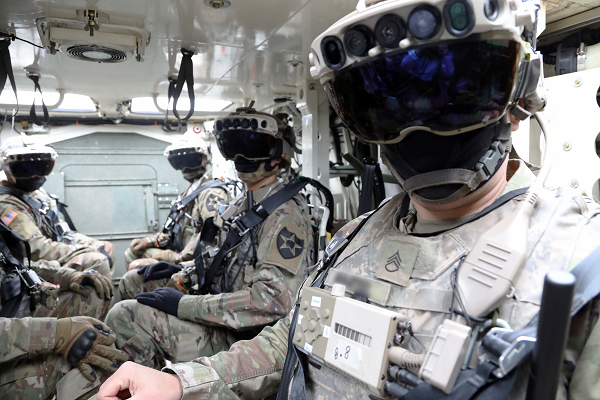Microsoft Scores $22B Army Contract for Hololens-Based AR Smart Googles
 Microsoft has won a contract from the U.S. Army worth a potential $22 billion to produce enhanced versions of its Hololens 2 smart goggles. The Integrated Visual Augmentation System (IVAS) devices provide better vision and more information about the environment around the soldier, with a built-in voice assistant and tactile controls to operate the modified headset.
Microsoft has won a contract from the U.S. Army worth a potential $22 billion to produce enhanced versions of its Hololens 2 smart goggles. The Integrated Visual Augmentation System (IVAS) devices provide better vision and more information about the environment around the soldier, with a built-in voice assistant and tactile controls to operate the modified headset.
IVAS Eyes
The IVAS goggle are modified from the Hololens 2, which Microsoft only sells for industrial and enterprise use right now. They can project three-dimensional maps and annotate the geography with details like addressees and weather reports pulled from a military database. The tech within also lets the wearer see in the dark or through smoke by relying on other sensors, and it can even stream video from cameras in a rifle scope or embedded in drones to let the soldiers see around corners.
It took two years for Microsoft and its military partners to adapt the Hololens 2 into a prototype capable of achieving all of the Army’s goals. The IVAS is much tougher and more resilient than the original model and has a much wider field of vision. One of the objectives in developing IVAS is to apply its augmented reality and machine learning functions to help the soldiers train, with rehearsals, in turn, training the AI within the device. With the success of the prototype, the Army signed Microsoft to a five-year deal with an additional five-year option to produce more than 120,000 IVAS devices. The full contract would earn Microsoft $21.88 billion, though a decade is a long time and the terms might change. The long-term plan is for the Army to distribute IVAS as part of standard combat infantry gear.
“The IVAS headset, based on HoloLens and augmented by Microsoft Azure cloud services, delivers a platform that will keep soldiers safer and make them more effective. The program delivers enhanced situational awareness, enabling information sharing and decision-making in a variety of scenarios,” Microsoft technical fellow Alex Kipman, who first unveiled the HoloLens in 2015, said in a blog post. “Microsoft has worked closely with the U.S. Army over the past two years, and together we pioneered Soldier Centered Design to enable rapid prototyping for a product to provide Soldiers with the tools and capabilities necessary to achieve their mission. We appreciate the partnership with the U.S. Army, and are thankful for their continued trust in transitioning IVAS from rapid prototyping to rapid fielding.”
Military AI
The U.S. military has been boosting its investment and development of AI-enabled tools for a while, both internally and with corporate partners. Not everyone at Microsoft is happy about it, though. A group wrote an open letter to Microsoft back when the original contract was signed in 2019 asking the company to cancel the deal because they didn’t want the HoloLens to be applied to combat.
But, IVAS is just one of several projects exploring this tech for military purposes. For instance, the Army is also working on the Joint Understanding and Dialogue Interface, JUDI, that will relay voice commands from soldiers to robotic vehicles. Meanwhile, the Navy recently started soliciting ideas for a virtual assistant for sonar operators looking for submarines. And the military research agency DARPA is working on creating a virtual assistant to improve efficiency and accuracy as part of the Perceptually-enabled Task Guidance (PTG) program. The agency wants a virtual assistant that can help parse the many complex tasks necessary to complete in the modern military. It’s not a concept limited to the U.S., either. The Russian military is working on something similar, testing a voice assistant in Marker combat drones, autonomous tanks. Russia has plans for AI in the sky too, adding a voice assistant named Rita to the new MiG-35 fighter jets. Rita is supposedly capable of offering ideas to pilots during combat.
Follow @voicebotai Follow @erichschwartz
US Military Unveils Plans for Developing an AI Assistant at DARPA
The US Army is Building a Voice Assistant Named JUDI to Control Robots
The US Navy Wants a Virtual Assistant to Help Hunt Submarines








